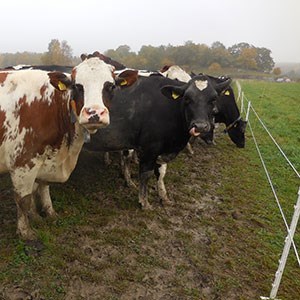Contact
Eva Spörndly, Senior Lecturer
Department of Animal Nutrition and Management, Ruminants, SLU
eva.sporndly@slu.se, +46 18 671632

The purpose of this project is to develop knowledge and understanding to enable rapid creation of highly trample-resistant grazing areas that are also attractive to grazing animals and to evaluate measures for areas that are particularly vulnerable to trampling.
When the number of livestock increases so does the effect on the ground underfoot, particularly those surfaces and pastures located relatively near the stable. Installing hardened surfaces would be costly and there is an extensive need for trample-resistant pens in the area near the stables. We currently only have limited knowledge of plant and seed mixtures that could quickly provide trample-resistant grazing.
The risk of trampling damage to particularly vulnerable areas, such as the entrance of pens, increases with the size of the herd. This is a major problem and the damage is often permanent or difficult to repair. Being able to quickly construct trample-resistant grazing and stabilize the soil surface in particularly sensitive areas would be of great practical importance for all herds and would facilitate daily work with the animals during the period that they are outside.
The purpose of this project is to develop knowledge and understanding to enable rapid creation of highly trample-resistant grazing areas that are also attractive to grazing animals and to evaluate measures for areas that are particularly vulnerable to trampling.
In the first part of the project we will study four new grass seed mixes with respect to their establishment and trample-resistance. Trampling damage will be documented after each overgrazing by photography and by measurement of the field coverage. Changes in botanical composition will be recorded to determine trampling resistance of the different varieties and species in seed mixtures.
The animals' selection of fodder and their preferred location will be recorded in behavioral studies together with the nutritional value of the fodder. In the second part of the project three different materials will be evaluated based on soil stabilizing ability on exposed surfaces. Stabilizing ability will be evaluated based on aerial photo analysis and recording of injuries in the field.
Eva Salomon (JTI), Nilla Nilsdotter-Linde (Department of Crop Production Ecology)
Eva Spörndly, Senior Lecturer
Department of Animal Nutrition and Management, Ruminants, SLU
eva.sporndly@slu.se, +46 18 671632